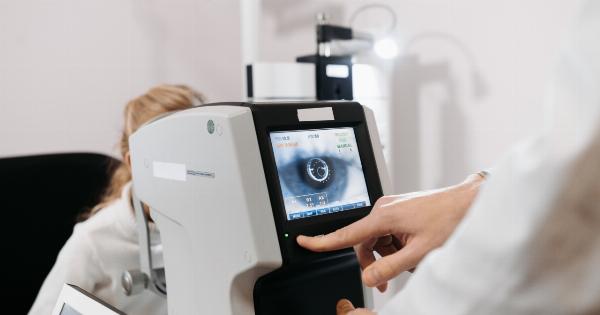When it comes to maintaining good overall health, it’s essential to pay attention to all aspects of your body.
While most people are aware of the connection between heart health and other organs such as the brain and kidneys, they often overlook the link between their eyes and heart health. In fact, several studies have found a direct relationship between these two vital organs.
The Link between Eye Diseases and Cardiovascular Problems
Research suggests that there is a significant association between certain eye diseases and various cardiovascular issues.
For instance, studies have shown that individuals with conditions like age-related macular degeneration (AMD) or diabetic retinopathy are more likely to have heart disease or stroke. These eye conditions affect the tiny blood vessels in the eyes, and the same blood vessels can be affected in the heart and brain, leading to cardiovascular complications.
Moreover, a study published in the British Journal of Ophthalmology found that individuals with atherosclerosis, a condition characterized by the buildup of plaque in the arteries, often develop retinal microvascular abnormalities.
This suggests that changes in the eye’s blood vessels can serve as indicators of similar changes in the heart’s blood vessels.
Shared Risk Factors for Eye Diseases and Heart Problems
Many risk factors contribute to both eye diseases and heart problems, further emphasizing the link between these two organs. Some common risk factors include:.
1. High Blood Pressure
Elevated blood pressure can damage the blood vessels not only in the heart but also in the eyes. The fragile blood vessels in the eyes are particularly susceptible to hypertension and can develop various eye conditions as a result.
2. High Cholesterol
When cholesterol levels rise, it can lead to the development of plaque in the arteries, including those in the eyes. This can impede blood flow and result in vision problems or even vision loss.
3. Diabetes
Diabetic individuals are at a higher risk of developing both eye diseases like diabetic retinopathy and cardiovascular problems.
The elevated blood sugar levels associated with diabetes can damage the blood vessels throughout the body, affecting the eyes and heart alike.
4. Smoking
Smoking is a known risk factor for several eye diseases such as cataracts and AMD. It also contributes to the development of heart disease by damaging blood vessels and increasing the risk of blood clots.
5. Obesity
Being overweight or obese not only increases the likelihood of heart disease but also raises the risk of various eye conditions, including glaucoma and cataracts.
By addressing these shared risk factors and adopting a heart-healthy lifestyle, individuals can effectively reduce the risk of both eye diseases and cardiovascular problems.
Early Indicators of Heart Disease Through Your Eyes
It’s essential to recognize that changes in the eyes can sometimes serve as early indicators of heart disease. One such example is the presence of tiny yellowish deposits called plaques on the eyelids or around the cornea.
These plaques are composed of cholesterol and can signal a higher risk of high cholesterol and heart disease.
In addition, some eye diseases can manifest as warning signs for cardiovascular issues. For instance, a condition known as retinal vein occlusion (RVO) occurs when the veins in the retina become blocked.
RVO can be an early indication of high blood pressure or diabetes, both of which significantly contribute to heart disease.
The Importance of Regular Eye Examinations
Regular eye examinations are not only crucial for maintaining good vision but also for identifying potential signs of underlying heart problems.
During an eye exam, ophthalmologists can assess the health of blood vessels and detect any abnormalities that may indicate cardiovascular issues.
Eye doctors may also use advanced imaging techniques such as optical coherence tomography (OCT) to evaluate the health of the retina and optic nerve.
Any changes or abnormalities observed during these tests would warrant further investigation into potential cardiovascular conditions.
Preventive Measures for Maintaining Eye and Heart Health
To maintain optimal eye and heart health, it is essential to incorporate the following practices into your daily routine:.
1. Eat a Heart-Healthy Diet
A diet rich in fruits, vegetables, lean proteins, and whole grains can promote cardiovascular health and benefit your eyes as well. Include foods such as salmon, oranges, spinach, and nuts, known for their high antioxidant content.
2. Exercise Regularly
Engaging in regular physical activity is not only beneficial for your heart but also for your eyes. Exercise helps regulate blood pressure and lowers the risk of developing both eye diseases and cardiovascular problems.
3. Manage Chronic Conditions
Keep chronic conditions such as high blood pressure, cholesterol, and diabetes under control by following the prescribed treatment plan. Regularly monitor these conditions with the help of healthcare professionals.
4. Don’t Smoke
If you currently smoke, make every effort to quit. Smoking is harmful to both your eyes and heart and significantly increases the risk of developing various eye diseases and cardiovascular complications.
5. Protect Your Eyes from Harmful Sunlight
Wear sunglasses that provide adequate UV protection whenever you are outdoors to shield your eyes from harmful ultraviolet rays. Prolonged exposure to the sun’s rays can contribute to the development of eye diseases.
Conclusion
Given the strong link between your eyes and heart health, it’s crucial to prioritize routine eye examinations and adopt a heart-healthy lifestyle. By doing so, you can significantly reduce the risk of both eye diseases and cardiovascular problems.
Remember, taking care of your eyes is not just about maintaining good vision; it’s about safeguarding your overall health and well-being.





























